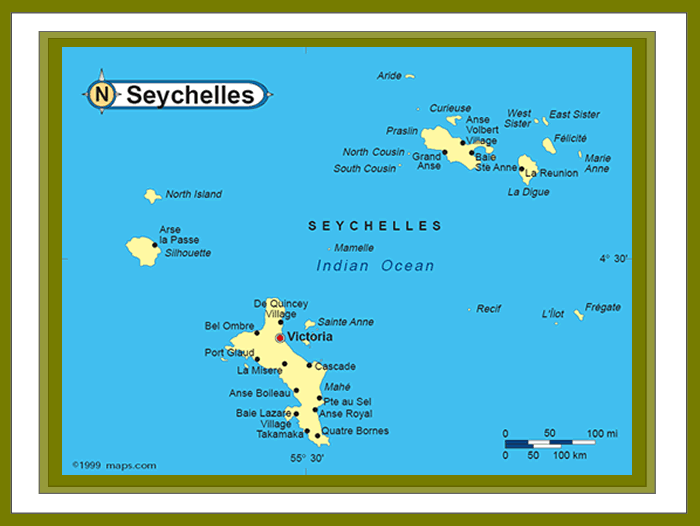 | |||||||
| |||||||
Map & Statistics for the Seychelles
ClimateThere are seasons in the Seychelles, and these depend largely on the trade winds that come bringing either warmer, wetter air or cooler, drier air. From October to Spring time its warm and wetter, and the rest of the year tradewinds from the southeast bring the cooler air and higher wind speeds. This is the windy season, so waves on the ocean are higher, and beaches are whippy windy. There are periods in Spring and Fall (March and October, respectively) when seas are calm, and this is a great time to visit the Seychelles, for some people. The highest rainfall will be around the islands of the Seychelles which have the highest elevations...in other words, the most mountainous islands have more rain. In Seychelles, this means Mahe and Silhouette.When to GoThe best time to visit the islands of the Seychelles is anytime! But if you have specific outdoor pursuits you want to explore while you're here, and you want to minimize the chances of being cancelled out by the wrong type of weather, here's a rough guide to the weather around the year. January sees the most rain, and July and August see the least amount of rainfall. The temperature and humidity are relatively stable year-round, hovering between 75 F and 90 F, and humidity around 80%. During the months between December and March, including December and March, you are more likely to encounter grayer, windier days due to cyclone activity elsewhere in the Indian Ocean. Nevertheless, this is one of the two peak seasons for traveling to the Seychelles, along with June and July.The LandThe Seychelles Islands lie about one thousand miles off the coast of Africa and a little bit south of the Equator. The land is made of granite on the inner islands, and the outer islands are made of coral that sticks above the water line, which is called atolls. The inner granite islands of the Seychelles are the tips of a giant plateau under the water, which broke off from the African continent when the plates shifted millions and millions of years ago. As for the types of plants and trees you'll find on the Seychelles, casuarina and coconut palm are the most common types of trees you'll find. Common animals would be the fruit bat, gecko, skink and tenrec. The tenrec is like a hedgehog, and it's originally from Madagascar. Giant tortoises are found here but are not common, since they were almost wiped out by settlers here a few centuries ago. Giant tortoises are found only on the Seychelles Islands and on the Galapagos Islands, by the way. The island of Aldabra has more than 100,000 giant tortoises, so the population is healthy and on its way to a comeback in the Seychelles. Giant tortoises are appreciated and protected by Seychelloise people. In fact, the giant tortoise is on the coat of arms of the Seychelles.
Aldabra Islands || Amirantes & Alphonse Islands || Bird Island || Denis Island || Felicite Island || La Digue || Mahe || North Island || Praslin || |
|||||||